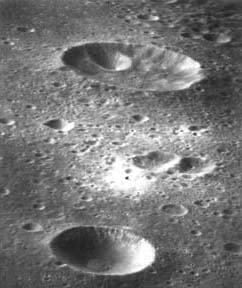Is it an In-y or an Out-y
Is it an In-y or an Out-y
Introduction
The direction of lighting in a photograph changes our perception of whether objects in the photograph protrude outward or project inward. Rotating the photograph can change these perceptions.
Material
A photograph of lunar craters like the one above. Or the one at the bottom of this page.
Click on the photograph above to see a larger version.
To Do and Notice
Look at the photograph notice whether it is covered with mounds or holes.
Turn this page over and look again. Notice any changes.
Notice at what angle of rotation the mounds become craters.
What's Going On?
We interpret the photograph based on the assumption that light
comes from above.
This will cause us to interpret an inverted photo of lunar craters to
be covered with mounds.
When light comes from the top left, the bottom right of a hole is
brightly illuminated.
The same lighting will illuminate the top left of a hill.
With experience people can learn to perceive the craters as mounds and vice-versa without rotating the picture.
So What?
When planetary scientists look at images of planets they must be careful not to be fooled into interpreting craters as mounds and vice versa.
Etc.
There is a popular children's game in which the participants hold a flashlight under their chins and illuminate their faces from below producing an unexpected and scary image.

|
Scientific Explorations with Paul Doherty |
|
22 May 2000 |